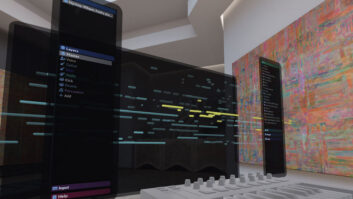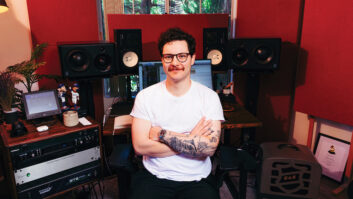

The Dangerous Music D-Box is a “greatest-hits” compilation that distills the company’s existing product line into a single-rackspace unit. Designed for pro studios or compact/portable DAW rigs that require an all-in-one control center, D-Box combines an 8-channel analog summing system (input via DB-25 connectors), a stereo audio source monitor-speaker switcher/controller, separate headphone system, talkback system and a mastering-quality digital-to-analog converter for all incoming digital audio.
Even with all of those features, the D-Box is priced at a reasonable $1,699, yet there are no corners cut. It uses the same THAT Corp. audio input receiver and output driver chips, the same Burr-Brown BB OPA134 op amps, hermetically sealed Aromat relays with silver contacts for switching audio and the same headphone power amps found in other Dangerous Music products.
D-BOX CONTROLS
The summing section has eight signal-present LEDs, one per channel, that glow even when low, -28dBu signals are present. The first six summing channels’ stereo bus pan positions are fixed: Channels 1, 3 and 5 are assigned to the left side, while channels 2, 4 and 6 are assigned to the right side of the stereo summing bus. Channels 7 and 8 both have panpots for manual placement in the center, using the center-detent or anywhere else across the stereo field. A Sum Output Trim control attenuates up to -12 dB of the stereo summing bus output.
For communication between studio and control room, the D-Box offers two front panel headphone jacks, each with a separate level control. However, there is no rear panel line-level output for driving an external headphone amplifier. The built-in talkback mic features front panel level control and a rear panel jack for remote operation. For monitoring, the D-Box has a L+R channel-summing switch and accommodates two sets of monitors, but it has no dedicated speaker mute button. You can de-select the input, but this mutes both speakers and headphones. In one-room studio setups, muting while keeping the same monitor level is handy when quickly changing between overdubbing using headphones and doing speaker playbacks.
LED-illuminated push buttons select between four stereo audio inputs. A Sum control monitors the internal 8-channel summing bus, while Analog switches to any external +4dBu or -10dBv source. DAW and CD switches route to external digital inputs.
HIDDEN FEATURES
Simultaneously holding both the Mono and Alt Spkr buttons puts the D-Box in Setup mode, which lets you use two hidden features. In Setup mode, you can monitor multiple stereo audio sources at once, which is useful during ADR/Foley sessions when you want to listen to your DAW’s audio with the production sound arriving on the analog input. You can also add 11.7 dB of gain to the external stereo analog source input (normally set to +4 dBu) for using consumer-grade -10dBv devices.
ON THE ROAD WITH D-BOX
Instead of testing the D-Box’s studio applications, I took a nontraditional approach for this review by installing D-Box in a Pro Tools road rig that I use to record playback loops and keyboard pads in a live show. The test rig comprised an Apple Mac Pro, Digidesign HD2 Accel system and a 192 I/O interface, clocked by an Apogee Big Ben. Installation went perfectly with the unit working as advertised the first time.
As this was a live mobile application, I used the 8-channel summing system differently. For certain songs, I mixed pre-recorded stems to feed our front-of-house and monitor mixing consoles. A DB-25 “Y” cord is required to feed the snake cable to FOH and monitor consoles and the D-Box at the same time.
Using aux sends in Pro Tools, I sent a stereo mix of two drum loops from the 192 I/O’s outputs 3 and 4. Outputs 5 and 6 ran a mix of two keyboard pads with effects, and output 7 had a count-off/click track for the drummer. I used output 8 to separate the boomy bass drum in the loops for mixing control, depending on the particular low-frequency capabilities of each venue’s installed P.A. system.
I could quickly hear a rough monitor mix of the band using the stereo digital path. Then by pushing Sum, I could hear and adjust (after solo’ing each stem) the individual mixes of the loops, pads, count-off/click and the loop’s bass drum. The front panel headphone monitor is ideal for this: Even on a noisy stage. I had plenty of level when driving my 55-ohm AKG K271 headphones.
Using D-Box in this arrangement worked better than I thought. The D-Box has a clear sound with plenty of headroom; as hot as I like to print levels in Pro Tools, the summing inputs never distorted. All the controls and buttons worked smoothly without clicks or pops. The talkback system has an unusual clarity and presence with no loud popping when you push the button.
IT’S D-LICIOUS
Despite its flawless operation in my non-traditional application, I need to mention some very minor criticisms. For easier operation and confidence in any scenario, it would be nice to have a stereo audio signal-present LED indicator, a larger master volume knob and a power-on/off switch. But with its small size, transparent sound, elegant design, and simple hookup and operation, D-Box is packed with everything you need for studio or mobile apps, and even some things you don’t need.
Dangerous Music, 607/965-8011, www.dangerousmusic.com.
Barry Rudolph is an L.A.-based recording engineer. Visit him online at
www.barryrudolph.com.

WATCH:
Setup Number One
WATCH:
Setup Number Two







